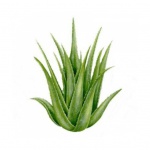 Aloe vera gel is a mucilaginous liquid obtained exclusively from the pulp of the leaves of A.barbadensis. Its main constituents are polysaccharides and it is used for a great variety of medicinal purposes, mainly in skin alterations. Aloe gel is composed, for the most part, of mucilaginous polysaccharides responsible for the plant’s great capacity to retain water, thanks to which it can survive in drought conditions. These polysaccharides usually contain different proportions of mannose, glucose and galactose. Among them are: glucomannans, glucomannans with glucuronic acid, galactogalacturonans, glucogalactomannans, galactoglucoarabinomananos and acetylated mannans (Vila Casanovas, R. et al, 2001). Among the mucilaginous polysaccharides of aloe include acemannan (aloeverose), which has aroused great interest for its pharmacological properties and as an active component of aloe gel, and aloeride, high molecular weight polysaccharide consisting of glucose, galactose, mannose and arabinose. Other identified minority components that may also contribute to its pharmacological action are: amino acids, glycoproteins, derivatives of chromones and pyrones, saponins, sterols, acids and organic salts, inorganic salts, minerals and trace elements, gibberilins, triglycerides, salicylic acid, lignins and vitamins .
Aloe vera gel is a mucilaginous liquid obtained exclusively from the pulp of the leaves of A.barbadensis. Its main constituents are polysaccharides and it is used for a great variety of medicinal purposes, mainly in skin alterations. Aloe gel is composed, for the most part, of mucilaginous polysaccharides responsible for the plant’s great capacity to retain water, thanks to which it can survive in drought conditions. These polysaccharides usually contain different proportions of mannose, glucose and galactose. Among them are: glucomannans, glucomannans with glucuronic acid, galactogalacturonans, glucogalactomannans, galactoglucoarabinomananos and acetylated mannans (Vila Casanovas, R. et al, 2001). Among the mucilaginous polysaccharides of aloe include acemannan (aloeverose), which has aroused great interest for its pharmacological properties and as an active component of aloe gel, and aloeride, high molecular weight polysaccharide consisting of glucose, galactose, mannose and arabinose. Other identified minority components that may also contribute to its pharmacological action are: amino acids, glycoproteins, derivatives of chromones and pyrones, saponins, sterols, acids and organic salts, inorganic salts, minerals and trace elements, gibberilins, triglycerides, salicylic acid, lignins and vitamins .
Aloe vera has re-epithelising properties, immunomodulatory, anti-inflammatory and is highly moisturizing, thus becoming an ideal ally to refresh, soothe and calm the most sensitive skin.
Composed mainly of palmitic acid (2-6%); stearic acid (15-25%); oleic acid (60-70%); linolenic acid (5-15%); linoleic acid (<1%), as well as an original unsaponifiable fraction that gives it a great moisturizing and emollient capacity. It contains antioxidants such as tocopherols (vitamin E) and catechins (which are also found in green tea). Other specific compounds have been detected as triterpene alcohols, whose property is to reduce inflammation; esters of cinnamic acids, which have a limited ability to absorb ultraviolet (UV) radiation, and lupeol, which prevents the effects of skin aging by inhibiting enzymes that degrade skin proteins. Shea butter also protects the skin by stimulating the production of structural proteins by specialized dermal cells.
This fat is known above all for its moisturizing properties, which is why it is used in the composition of numerous preparations for the cosmetic industry.
